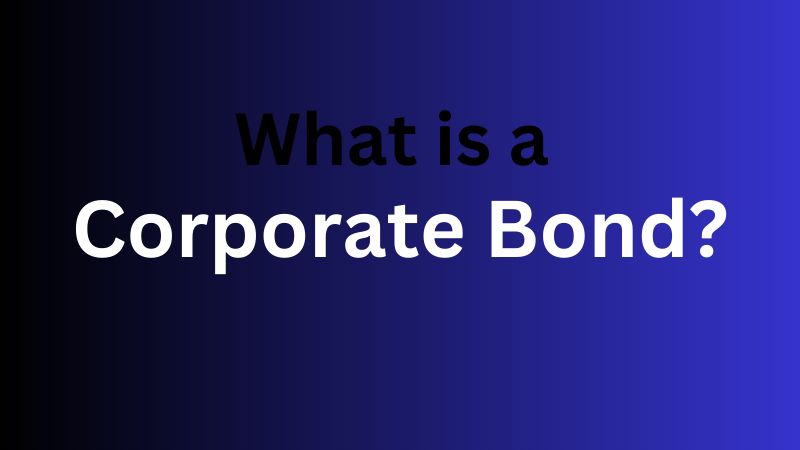What is a Corporate Bond?

A corporate bond is a debt security issued by a corporation to raise capital. When an investor buys a corporate bond, they are essentially loaning money to the corporation for a specified period of time. The corporation promises to pay the investor a fixed rate of interest on a regular basis until the bond matures.
Corporate bonds can be purchased by individual investors, institutional investors such as pension funds, and other corporations. The creditworthiness of the corporation issuing the bond is a key factor in determining the interest rate on the bond, with higher-risk corporations offering higher interest rates to compensate investors for the increased risk.
How Do Corporate Bonds Work?
Corporate bonds are a type of debt security issued by companies to raise capital. When a company issues a bond, it is essentially borrowing money from investors who buy the bonds. In exchange for buying the bond, investors receive regular interest payments (called coupon payments) from the company, and the return of their principal investment when the bond matures.
The interest rate on the bond, or the coupon rate, is typically set at the time the bond is issued and remains fixed over the life of the bond. Corporate bonds typically have a maturity of 10 years or more, although some may have shorter or longer maturities.
Corporate bonds can be bought and sold on the bond market, which is typically an over-the-counter (OTC) market rather than a centralized exchange. The price of a bond on the secondary market may be higher or lower than its face value, depending on factors such as changes in interest rates, the financial health of the issuing company, and investor demand.
Corporate bonds are generally considered to be less risky than stocks, but riskier than government bonds since the financial health of the issuing company can affect the bond’s value and interest payments. Investors typically evaluate the creditworthiness of the issuing company before investing in its bonds, looking at factors such as the company’s financial statements, credit ratings, and business prospects.
Brief History of Corporate Bonds
Corporate bonds have a long history dating back to the early days of capitalism. In the early modern period, businesses needed large sums of money to finance their operations and expand their enterprises. At that time, borrowing from individuals was the primary means of raising capital, and merchants and wealthy individuals lent money to businesses in exchange for promissory notes.
In the 18th and 19th Centuries
As capitalism developed and the scale of business operations grew, corporations began to issue bonds as a way of raising capital from a larger pool of investors. The first corporate bond issuances were typically made by railroad companies, which needed large amounts of capital to build their infrastructure. In the United States, the first corporate bond was issued by the Pennsylvania Railroad Company in 1843.
The use of Corporate Bonds expanded in the 20th century
As more and more companies began to issue them to raise capital. In the 1920s, the growth of the bond market was fueled in part by the development of investment trusts, which used borrowed money to invest in stocks and bonds. This helped to create a market for corporate bonds and increased their popularity among investors.
In the post-World War II Era
The corporate bond market grew rapidly as businesses sought to finance the expansion of their operations. The rise of financial intermediaries such as mutual funds and pension funds also helped to fuel the growth of the market, as these institutions invested large sums of money in corporate bonds on behalf of their clients.
Today
The corporate bond market is a large and complex financial market, with trillions of dollars in outstanding debt issued by companies of all sizes and from all sectors of the economy. The market has evolved over time, with changes in regulations, technology, and investor preferences shaping its development. Nonetheless, the basic structure and function of corporate bonds have remained largely the same over the years, as they continue to provide an important source of financing for businesses around the world.
Types of Corporate Bonds
There are several types of corporate bonds that companies may issue, including:
- Investment-grade bonds: These are bonds issued by companies with high credit ratings (usually BBB- or higher) and a low risk of default. They typically offer lower interest rates than other types of bonds but are considered to be less risky investments.
- High-yield or junk bonds: These are bonds issued by companies with lower credit ratings (usually BB or lower) and a higher risk of default. They typically offer higher interest rates to compensate for the increased risk.
- Convertible bonds: These are bonds that can be converted into shares of the issuing company’s stock at a specified price and time. They offer investors the potential for capital appreciation if the company’s stock price rises, while also providing a fixed income stream in the form of coupon payments.
- Callable bonds: These are bonds that can be redeemed by the issuing company before the bond’s maturity date. Callable bonds typically offer higher interest rates than non-callable bonds, but investors run the risk of having their investment called away before they expect it.
- Zero-coupon bonds: These are bonds that do not pay interest over the life of the bond, but are instead sold at a discount to their face value and redeemed at full face value when the bond matures. They offer the potential for a higher return than traditional bonds, but investors must be willing to forego regular interest payments.
- Floating rate bonds: These are bonds whose interest rate is tied to a benchmark, such as the London Interbank Offered Rate (LIBOR), and adjusts periodically as the benchmark rate changes. They offer protection against rising interest rates but may offer lower initial interest rates than fixed-rate bonds.
- Perpetual bonds: These are bonds that have no fixed maturity date and pay interest indefinitely. They are rare, but may be issued by companies with a long-term investment horizon or who want to avoid the need to repay the principal at a future date.
Advantages and Disadvantages of Corporate Bonds
Investors should carefully consider the advantages and disadvantages of corporate bonds before investing and should consult with a financial advisor to determine whether corporate bonds are an appropriate investment for their individual needs and risk tolerance. Below is a list of their advantages and disadvantages.
Advantages of Corporate Bonds:
- Corporate bonds offer a fixed interest payment over the life of the bond, providing investors with a predictable income stream.
- Corporate bonds can help diversify a portfolio of investments, as they may have different risk and return characteristics than other assets such as stocks.
- Convertible bonds and other types of bonds may offer the potential for capital appreciation if the issuer’s stock price rises.
- Investment-grade corporate bonds are typically issued by companies with strong credit ratings and a low risk of default, providing investors with a relatively safe investment.
Disadvantages of Corporate Bonds:
- Corporate bond prices are sensitive to changes in interest rates, and a rise in interest rates can cause the price of the bond to fall, potentially resulting in a loss for investors.
- Corporate bonds are subject to the risk of default, and the creditworthiness of the issuing company can affect the bond’s value and interest payments.
- The market for corporate bonds may be less liquid than other financial markets, making it difficult for investors to buy or sell bonds quickly.
- Inflation can erode the purchasing power of the fixed-interest payments offered by corporate bonds, potentially resulting in a loss for investors.
- The price of corporate bonds may be influenced by market conditions, and changes in economic conditions or investor sentiment can cause the value of the bond to fluctuate.
How to Invest in Corporate Bonds?
Investing in corporate bonds can be a good way to generate fixed income and diversify your investment portfolio. Here are some steps you can take to start investing in corporate bonds:
Determine your investment goals and risk tolerance
Before investing in corporate bonds, you should have a clear understanding of your investment goals and how much risk you are willing to take on.
Research different types of corporate bonds
As discussed earlier, there are various types of corporate bonds with different characteristics and risks. It is important to research and understand the differences between them to determine which type of bond is right for you.
Research the creditworthiness of the issuing company
Since corporate bonds are subject to credit risk, it is important to research the financial health of the company issuing the bond. You can review the company’s financial statements, credit ratings, and other publicly available information to assess the company’s creditworthiness.
Open a brokerage account
To buy and sell corporate bonds, you will need to open a brokerage account with a reputable broker. There are many online brokers that offer access to a wide variety of corporate bonds.
Choose the bonds you want to invest in
Once you have identified the types of corporate bonds you want to invest in and opened a brokerage account, you can start researching individual bonds to invest in. You can use your broker’s platform to view available bonds, compare their yields, credit ratings, and other characteristics, and choose the ones that meet your investment goals.
Place an order
Once you have chosen the bonds you want to invest in, you can place an order with your broker to buy the bonds. You will typically need to provide the amount you want to invest, the bond ticker symbol, and other details to complete the purchase.
How Much Money to Start With?
The minimum amount of money required to buy corporate bonds can vary depending on the bond issuer and the broker you use to make the purchase. Some brokers may require a minimum investment of $1,000 or more to purchase a single bond, while others may have lower minimum investment requirements.
In addition to the minimum investment requirement, investors should also consider other costs associated with investing in corporate bonds, such as brokerage fees, commissions, and any other transaction costs.
How are Corporate Bonds Rated?
Corporate bonds are rated by independent credit rating agencies such as Moody’s Investors Service, Standard & Poor’s, and Fitch Ratings. These agencies assess the creditworthiness of the bond issuer and assign a rating based on the issuer’s ability to repay the bond’s principal and interest payments in a timely manner.
Credit rating agencies use a standardized rating system that typically ranges from AAA (highest credit quality) to D (default). The specific rating categories and definitions may vary slightly among the different rating agencies, but generally, they use a similar scale. Here is a typical rating scale used by these agencies:
Investment Grade:
- AAA: Extremely strong capacity to meet financial obligations
- AA: Very strong capacity to meet financial obligations
- A: Strong capacity to meet financial obligations
- BBB: Adequate capacity to meet financial obligations
Speculative Grade:
- BB: Less vulnerable to non-payment than other speculative issues
- B: More vulnerable to non-payment than BB-rated issues
- CCC: Currently vulnerable and dependent on favorable business, financial, and economic conditions to meet financial obligations
- CC: Highly vulnerable to non-payment
- C: Near default with some prospect of recovery of principal and interest
- D: Defaulted on payment
Conclusion
Investing in corporate bonds can be a complex process, so it is important to do your research, and carefully consider the costs and risks, advantages and disadvantages of investing in corporate bonds. Most importantly consult with a financial advisor to determine whether corporate bonds are an appropriate investment for your individual needs and risk tolerance.


